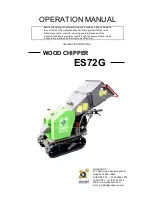
RT-SVX060A-GB
22
4
UNT-PRC002-GB
Technical Data
FWD
08
12
20
30
45
Power supply
(V/Ph/Hz)
230/1/50
Capacities
Cooling capacity on water (1)
(kW)
5,2
8,3
15
18,8
30,1
Heating capacity on water (2)
(kW)
6,3
11,9
18,9
20,9
38,2
Fan motor
(type)
2 x direct drive centrifugal
Fan power input (3)
(kW)
0,23
0,46
0,65
1,04
1,51
Current amps (3)
(A)
1,1
2,2
3,1
4,7
5,5
Start-up amps
(A)
3,2
5,5
9,3
14,1
16,5
Air flow
minimum
(m
3
/h)
490
980
1400
1800
2700
nominal
(m
3
/h)
820
1650
2300
3000
4500
maximum
(m
3
/h)
980
1970
2600
3600
5400
Main coil
Water entering/leaving connections
(type)
ISO R7 rotating female
(Dia)
3/4"
3/4"
1 1/2"
1 1/2"
1 1/2"
Electric heater (accessory for blower only)
Electric power supply
(V/Ph/Hz)
230/1/50
230/1/50 or 400/3/50
400/3/50
400/3/50
400/3/50
Heating capacity
(kW)
2/4
8
10
12
12
Hot water coil (accessory for blower only)
Heating capacity (4)
(kW)
6,3
12
17,4
22,4
34,5
G2 filter (filter box accessory)
Quantity
2
2
2
2
2
Dimensions ( LxWxth)
(mm)
386x221x8
486x271x8
586x321x8
586*421*8
586*621*8
G4 filter (filter box accessory)
Quantity
-
2
2
2
2
Dimensions ( LxWxth)
(mm)
-
486x264x48
586x314x48
586*414*48
586*614*48
Condensate pump (accessory)
(type)
Centrifugal
Water flow - lift height
(l/h - mm)
24 - 500
Not available for FWD30 and FWD45
Sound level (L/M/H speed)
Sound pressure level (5)
(dB(A))
36/40/43
38/41/44
46/50/53
47/52/57
47/52/58
Sound power level (5)
(dB(A))
46/50/53
48/51/54
56/60/63
57/62/67
57/62/68
Unit dimensions
Width x Depth
(mm)
890 x 600
1090 x 710
1290 x 820
1290 x 970
1290 x 1090
Height
(mm)
250
300
350
450
650
Shipped unit dimensions
Width x Depth
(mm)
933 x 644
1133 x 754
1333 x 864
1333 x 1008
1333*1133
Height
(mm)
260
310
360
460
660
Weight
(kg)
32
46
61
76
118
Colour
galvanised steel
Recommended fuse size
Unit alone (aM/gI)
(A)
8/16
8/16
8/16
8/25
8/25
Unit with electric heater (gI)
(A)
16 (2kW),25 (4kW)
40 (230V),3*16 (400V)
3*20
3*25
3*25
(1) Conditions: Water entering/leaving temperature: 7/12 °C, Air inlet temperature 27/19°C DB/WB - Nominal air flow
(2) Conditions: Water entering/leaving temperature: 50/45 °C, Air inlet temperature 20°C DB - Nominal air flow
(3) At high speed with nominal air flow.
(4) Water entering/leaving temperature 90/70 °C, air inlet temperature 20 °C DB, Nominal air flow.
(5) A rectangular glass wool duct 1m50 long is placed on the blower.The measurement is taken in the room containing the blower unit.
Heat exchanger operating limits:
FWD:
*water temperature: max 100° C
*absolute service pressure: min 1 bar/max 11 bars
Accessories - Hot water coil:
*water temperature: min. +2° C/max. 100° C
*absolute service pressure: min 1 bar/max 11 bars
Supply fan Airflow measurement option
The airflow measurement option when selected is
associated with an air differential pressure sensor which
measures the pressure difference before the inlet nozzle
and inside the inlet nozzle.
Unit air flow can be calculated on the basis of the
differential pressure (difference in pressure of the static
pressures) in keeping with the following equation:
Qv in [m3/h] and
∆
p in [Pa]
N number of fans
k takes into account the specific nozzle characteristics.
Connection on the unit side is acomplished via a pre-
mounted T tube connector. This tube connector is suited
for pneumatic hoses with an internal diameter of 4 mm.
k factors:
Fan diameter
400
450
500
k-factor
188
240
281
According to the option chosen, airflow or fan RPM can
be read directly on the optional display or should be
determined by connecting a pressure drop meter to the
pre mounted T connector.
Setup is -20%/+30% variation versus factory setting
(190m3h-1/kW @ 250 Pa).
Gas Pipework Installation
Installation of gas piping (to be performed
by the contractor)
The installation rules for public buildings shall be
followed: refer to the brochure in the “Journal Officiel”
number 1477-1 (France only).
The gas supply piping and the gas stop valve shall be
dimensioned to guarantee the gas supply pressure at the
unit’s inlet when it is functioning at full capacity.
It is recommended to install one expansion valve as
close as possible to each installed unit. The piping must
be self-supporting before the final branch connection
to the unit. Allow for a dust trap (filter) upstream of the
connection to the unit. Search for gas pipe leaks using
tensio-active product such as “Teepol” or “1000 bulles”
or another equivalent method. Soapy water must not be
used.
WARNING!
Never use a flame to search for leaks. The required gas
pressures at the unit’s inlet connection are specified
in table «Marking Category of gas section in different
countries»
CAUTION!
The piping must not exert any stress on the branch
connection to the burner.
The heating system must be isolated by the gas stop
valve on the gas supply piping during the pressure tests,
as soon as the pressure exceeds 0.060 bar (60 mbar).
If pressure greater than 0.060 bar is applied to the gas
valve inlet the unit may be damaged. In this case it is
mandatory to add a pressure reducer.
Connect condensation pipe for modulating burner.
2 stages burner is not supposed produce condensate
and the small amount of condensate possibly produced
in particular working conditions will in case evaporate
Figure 9 - Typical Gas Supply pipework
KEY
1
Main burner gas solenoid valve
2
Pilot burner gas solenoid valve
3
Pressure stabiliser
4
Safety gas solenoid valve
5
Gas filter (small section)
6
Anti-vibration joint
7
Gas filter (large section)
8
Gas valve
Installation
















































